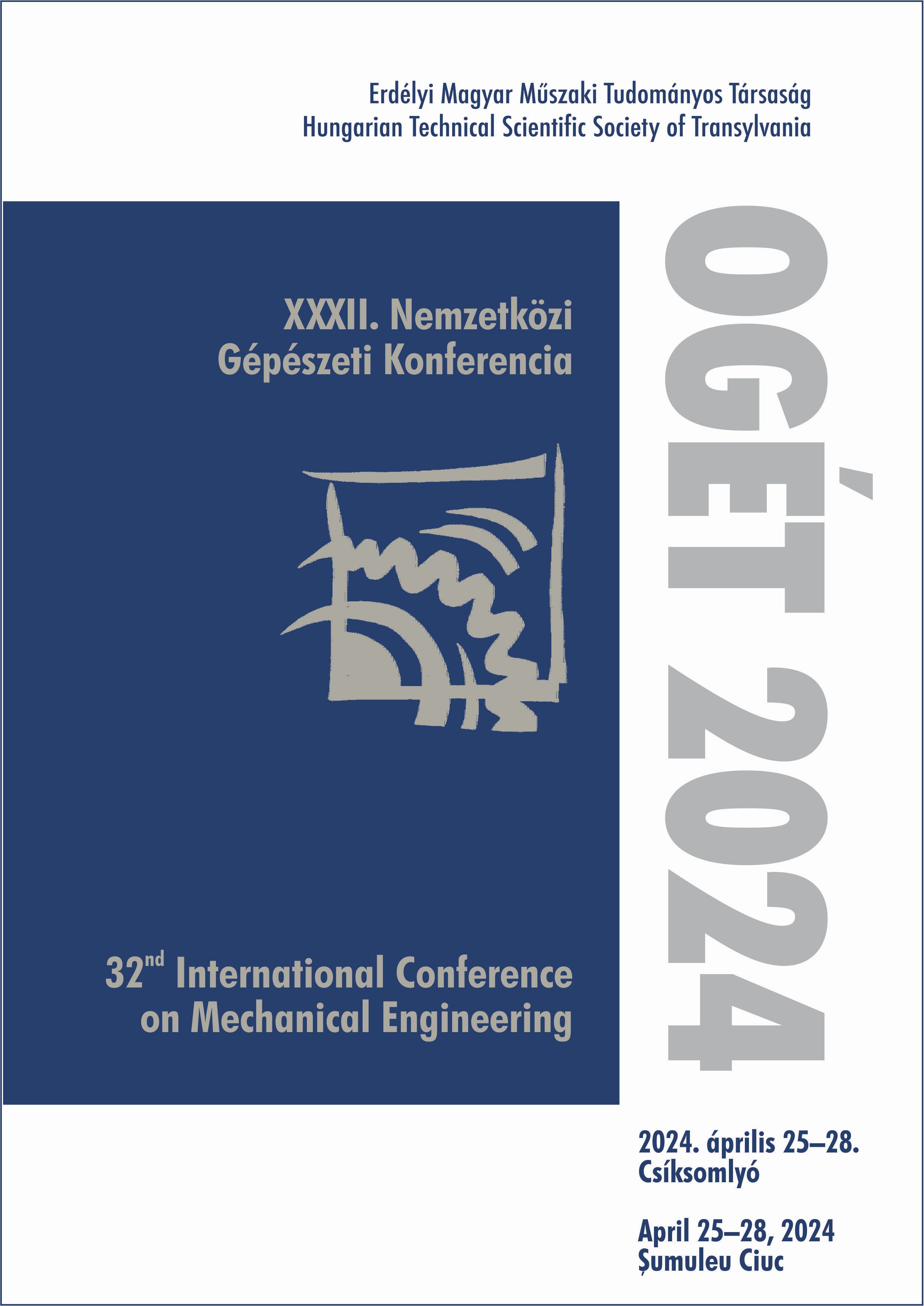Térdprotézis kopásának numerikus vizsgálata a protézis méretének függvényében
Numerical study of knee prosthesis wear as a function of prosthesis size
Keywords:
multibody simulations, wear, TKA dimensions, /, többtestdinamika, kopás, protézis geometriaAbstract
Wear is a key factor that significantnly limits the survival of total knee arthroplastys (TKAs). Wear itself is known to be highly dependent on load, local kinematics taking place in the knee joint and presumably on the geometry of the TKA. This article has investigated, by means of multibody models, how different TKA sizes and TKA-related geometric parameters affect wear during squatting and gait motion. It has been demonstrated that wear rate does increase, closely linearly, as a function of TKAs size, while the influence of TKA-related geometric parameters on wear propagation can be described by linear or quadratic functions. These results, together with the newly introduced dimensionless parameters, demonstrate that the wear rate of TKAs can be reduced by choosing the right dimensions.
Kivonat
A kopás olyan kulcsfontosságú tényező, amely nagymértékben korlátozza a teljes felszínpótló térdízületi protézisek élettartamát. A kopás maga nagymértékben függ a terheléstől, a térdízületben kialakuló helyi kinematikától és feltehetően a protézis geometriájától. Ez a tanulmány többtestdinamikai modellek segítségével vizsgálja, hogy a különböző térdprotézisméretek és a térdprotézisekkel kapcsolatos geometriai paraméterek hogyan befolyásolják a kopást a guggolás és a járás során. Kimutattuk, hogy a kopás mértéke a térdprotézis méretének függvényében közel lineárisan növekszik, míg a kopás terjedése a protézis főbb befoglaló méreteinek függvényében lineáris vagy kvadratikus függvényekkel írható le. Ezek az eredmények, valamint az újonnan bevezetett dimenziótlan paraméterek rávilágítanak arra, hogy a térdiprotézis kopásának mértéke, a méretek megfelelő megválasztásával, csökkenthető.
References
A. Fuchs, P. Häussermann, D. Hömig, B. G. Ochs, T. Klopfer, C. A. Müller, P. Helwig, L. Konstantinidis. 10-year follow-up of the Columbus knee prostheses system in a prospective multicenter study.
Archives of Orthopaedic and Trauma Surgery, 142, 2875-2883, 2022.
J. T. Evans, R. W. Walker, J. P. Evans, A. W. Blom, A. Sayers, M. R. Whitehouse. How long does a knee replacement last? A systematic review and meta-analysis of case series and national registry reports with more than 15 years of follow-up. Lancet, 393, 655-663, 2019. Archives of Orthopaedic and Trauma Surgery, 142, 2875–2883, 2022.
P. F. Sharkey, P. M. Lichstein, C. Shen, A. T. Tokarski, J. Parvizi. Why are total knee arthroplasties failing today – Has anything changed after 10 years? Journal of Arthroplasty, 29, 1774-1778, 2014.
J. F. Archard, W. Hirst. The wear of metals under unlubricated conditions. Proceedings of the Royal Society A, 236, 397–410, 1956.
M. Turell, A. Wang, A. Bellare. Quantification of the effect of cross-path motion on the wear rate of ultra-high molecular weight polyethylene. Wear, 255, 1034–1039, 2003.J. F
B. Innocenti, L. Labey, A. Kamali, W. Pascale, S. Pianigiani. Development and Validation of a Wear Model to Predict Polyethylene Wear in a Total Knee Arthroplasty: A Finite Element Analysis. Lubricants, 2(4), 193-205, 2014.
G. Fekete, D. Sun, Y. Gu, P. D. Neis, N. F. Ferreira, B. Innocenti, B. M. Csizmadia. Tibiofemoral wear in standard and non-standard squat: Implication for total knee arthroplasty. Muscle, Ligaments and Joints Journal, 7, 520-528, 2017.
A. Abdelgaied, F. Liu, C. Brockett, L. Jennings, J. Fisher, Z. Jin. Computational wear prediction of artificial knee joints based on a new wear law and formulation. Journal of Biomechanics, 44, 1108–1116, 2011.
S. T. O’Brien, E. R. Bohm, M. J. Petrak, U. P. Wyss, J-M. Brandt. An energy dissipation and cross shear time dependent computational wear model for the analysis of polyethylene wear in total knee replacements. Journal of Biomechanics, 47, 1127-1133, 2014.
B. Innocenti, G. Fekete, S. Pianigiani. Biomechanical Analysis of Augments in Revision Total Knee Arthroplasty. Journal of Biomedical Engineering, 140, 111006, 2018.
M. B. Collier, C. A. Engh, K. M. Hatten, S. T. Ginn, T. M. Sheils, G. Engh. Radiographic assessment of the thickness lost from polyethylene tibial inserts that had been sterilized differently. The Journal of Bone and Joint Surgery, American Volume, 90, 1543-52, 2008.
G. Fekete. Computational study on lateral and medial wear characterization in knee implants by a multibody dynamic system. Acta Mechanica, 232, 1075-1086, 2021.
S. Affatato, L. Grillini, S. Battaglia, P. Taddei, E. Modena, A. Sudanese. Does knee implant size affect wear variability? Tribology International, 66, 174-181, 2013.
G. Serrancolí, C. Alessandro, M. C. Tresch. The Effects of Mechanical Scale on Neural Control and the Regulation of Joint Stability. International Journal of Molecular Sciences, 22 (4), 1-14, 2021.
International Organization for Standardization, implants for surgery – wear of total knee-joint prostheses:
ISO-14243-1, 2009.
B. J. Hunt, T. J. Joyce. A Tribological Assessment of Ultra High Molecular Weight Polyethylene Types GUR 1020 and GUR 1050 for Orthopedic Applications. Lubricants, 4 (3), 1-10, 2016.
R. M. Cowie, A. Briscoe, J. Fisher, L. M. Jennings. Wear and Friction of UHMWPE-on-PEEK OPTIMA. Journal of Mechanical Behavior of Biomedical Materials, 89, 65-71, 2019.
C. L. Brockett, S. Carbone, J. Fisher, L. M. Jennings. Influence of conformity on wear of total knee replacement: An experimental study. Journal of Engineering in Medicine, 232, 127-134, 2017.
S. T. O’Brien, Y. Luo, J-M. Brandt. In-vitro and in-silico investigations on the influence of contact pressure on cross-linked polyethylene wear in total knee replacements. Wear, 332-332, 687-693, 2015.
C. K. Fitzpatrick, C. W. Clary, P. J. Laz, P. J. Rullkoetter. Relative contributions of design, alignment, and loading variability in knee replacement mechanics. Journal of Orthopaedic Research, 30, 2015-2024, 2012.
M. E. Berend, S. R. Small, M. A. Ritter, C. A. Buckley, J. C. Merk, W. K. Dierking. Effects of Femoral Component Size on Proximal Tibial Strain With Anatomic Graduated Components Total Knee Arthroplasty. The Journal of Arthroplasty, 25, 58-63, 2010.


